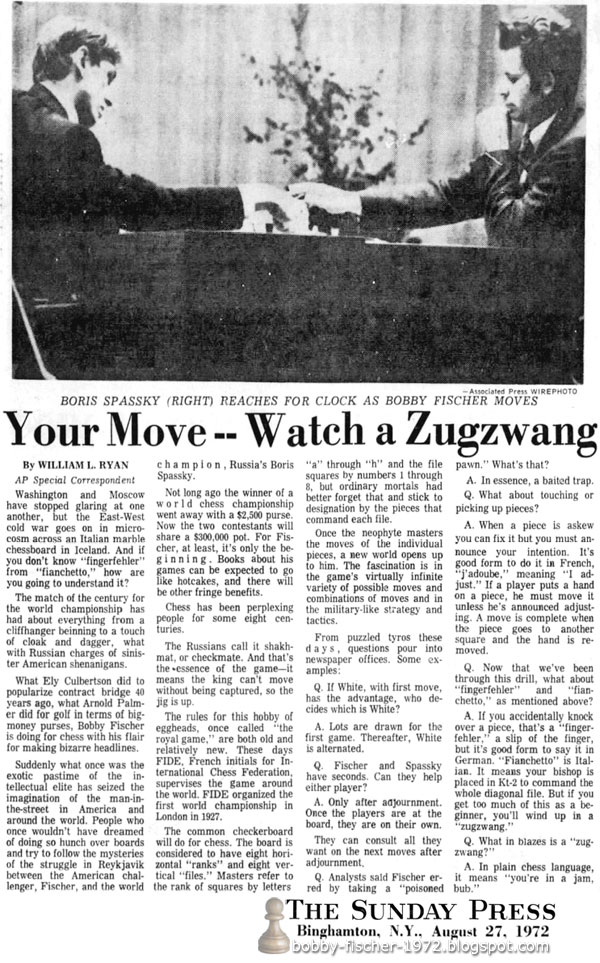Press and Sun-Bulletin Binghamton, New York Sunday, August 27, 1972 - Page 3
Your Move -- Watch a Zugzwang
By William L. Ryan, AP Special Correspondent
Washington and Moscow have stopped glaring at one another, but the East-West cold war goes on in microcosm across an Italian marble chessboard in Iceland. And if you don't know “fingerfehler” from “fianchetto,” how are you going to understand it?
The match of the century for the world championship has had about everything from a cliffhanger beginning to a touch of cloak and dagger, what with Russian charges of sinister American shenanigans.
What Ely Culbertson did to popularize contract bridge 40 years ago, what Arnold Palmer did for gold in terms of big-money purses, Bobby Fischer is doing for chess with his flair for making bizarre headlines.
Suddenly what once was the exotic pastime of the intellectual elite has seized the imagination of the man-in-the-street in America and around the world. People who once wouldn't have dreamed of doing so hunch over boards and try to follow the mysteries of the struggle in Reykjavik between the American challenger, Fischer, and the world champion, Russia's Boris Spassky.
Not long ago the winner of a world chess championship went away with a $2,500 purse. Now the two contestants will share a $300,000 pot. For Fischer, at least, it's only the beginning. Books about his games can be expected to go like hotcakes, and there will be other fringe benefits.
Chess has been perplexing people for some eight centuries.
The Russians call it shakhmat, or checkmate. And that's the essence of the game—it means the king can't move without being captured, so the jig is up.
The rules for this hobby of eggheads, once called “the royal game,” are both old and relatively new. These days FIDE, French initials for International Chess Federation, supervises the game around the world. FIDE organized the first world championship in London in 1927.
The common checkerboard will do for chess. The board is considered to have eight horizontal “ranks” and eight vertical “files”. Masters refer to the rank of squares by letters “a” through “h” and the file squares by numbers 1 through 8, but ordinary mortals had better forget that and stick to designation by the pieces that command each file.
Once the neophyte masters the moves of the individual pieces, a new world opens up to him. The fascination is in the game's virtually infinite variety of possible moves and combinations of moves and in the military-like strategy and tactics.
From puzzled tyros these days, questions pour into newspaper offices. Some examples:
Q. If White, with first move, has the advantage, who decides which is White?
A. Lots are drawn for the first game. Thereafter, White is alternated.
Q. Fischer and Spassky have seconds. Can they help either player?
A. Only after adjournment. Once the players are at the board, they are on their own.
They can consult all they want on the next moves after adjournment.
Q. Analysts said Fischer erred by taking a “poisoned pawn.” What's that?
A. In essence, a baited trap.
Q. What about touching or picking up pieces?
A. When a piece is askew you can fix it but you must announce your intention. It's good form to do it in French, “j'adoube,” meaning “I adjust.” If a player puts a hand on a piece, he must move it unless he's announced adjusting. A move is complete when the piece goes to another square and the hand is removed.
Q. Now that we've been through this drill, what about “fingerfehler” and “fianchetto,” as mentioned above?
A. If you accidentally knock over a piece, that's a “fingerfehler,” a slip of the finger, but it's good form to say it in German. “Fianchetto” is Italian. It means your bishop is placed in Kt-2 to command the whole diagonal file. But if you get too much of this as a beginner, you'll wind up in a “zugzwang.”
Q. What in blazes is a “zugzwang?”
A. In plain chess language, it means “you're in a jam, bub.”
























